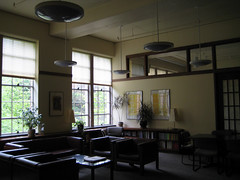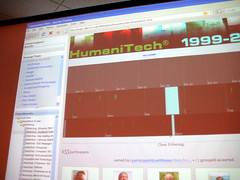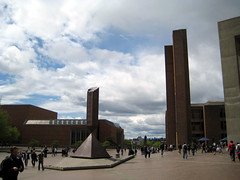- UC Irvine HumaniTech panel on “Humanities and Technology: The Past Ten Years, The Next Ten Years,” May 19, 2009
- Writers House at Rutgers University: Homepage | Photos from site visit
- University of Washington DUB (Design Use Build) Program in Human-Computer Interaction and Design
- Alan Liu, “Literature+”
- Literature+ graduate course
- “Literature+,” Currents in Electronic Literacy, Spring 2008
- The unstable continuum between building and interpreting:
- Model
- Adaptation
- Translation
- Performance
- Rendering
- Simulation
- Deformance
- Edition
- Interpretation
May 2009
| 2009 |
Notes and Links for “Introduction to a Research Slam” (May 22, 2009)Categories Uncategorized Uncategorized
|
| 2009 |
“Introduction to a Research Slam” (UC Santa Barbara)Categories Talks Talks
|
“Introduction to a Research Slam.” University of California, Santa Barbara. 22 May 2009.
| 2009 |
“Strange Bookshelves” (University of California, Irvine)Categories Audio/Video , Talks Audio/Video , Talks
|
“Strange Bookshelves.” Panel on “Humanities and Technology: The Past Ten Years, The Next Ten Years.” HumaniTech. University of California, Irvine. 19 May 2009.
| 2009 |
“The End of the End of the Book: Dead Books, Lively Margins, and Social Computing” (U. Michigan, Ann Arbor)Categories Talks Talks
|
 “The End of the End of the Book: Dead Books, Lively Margins, and Social Computing.” Conference on “Bookishness: The New Fate of Reading in the Digital Age.” University of Michigan, Ann Arbor. 15 May 2009. (Photos of campus and event)
“The End of the End of the Book: Dead Books, Lively Margins, and Social Computing.” Conference on “Bookishness: The New Fate of Reading in the Digital Age.” University of Michigan, Ann Arbor. 15 May 2009. (Photos of campus and event)
| 2009 |
“Literature+” (U. Washington)Categories Talks Talks
|
“Literature+” Simpson Center. University of Washington, Seattle. 8 May 2009.
 This talk/seminar focuses on how digital technologies now bring the core paradigms of research disciplines into close proximity, forcing such uncomfortable questions for the humanities (especially, literature departments) as: “what is ‘interpretation’ for?” or “what is the future of interpretation?”
This talk/seminar focuses on how digital technologies now bring the core paradigms of research disciplines into close proximity, forcing such uncomfortable questions for the humanities (especially, literature departments) as: “what is ‘interpretation’ for?” or “what is the future of interpretation?”
| 2009 |
“When Was Linearity?: Linear Thought, Graphics, and Freedom in the Age of Knowledge Work” (U. Washington)Categories Talks Talks
|
“When Was Linearity?: Linear Thought, Graphics, and Freedom in the Age of Knowledge Work.” Simpson Center. University of Washington, Seattle. 7 May 2009.
- Talk Abstract: “On May 7-8, 2009 the Simpson Center will host Alan Liu, Professor and Chair of the Department of English, University of California, Santa Barbara, as the first Digital Humanities Commons Visiting Scholar. His public talk, ‘Linear Thought, Graphics, and Freedom in the Age of Knowledge Work,’ will address the shift from print-based linear thought to digital principles of non-linear movement. Liu will also conduct an informal seminar with faculty and graduate students.”
- Related seminar taught by Joseph Milutis at U. Washington: “Creative Destruction: Reading Alan Liu” (May 1 and 8, 2009)
- Photos of campus and Simpson Center
| 2009 |
Notes for Seminar on “Literature+” (Simpson Center, U. Washington)Categories Uncategorized Uncategorized
|
What is the future of “interpretation”?
Department Projects
- Web Pages & Database-to-Web Sites (“Web 1.0” and “Web 1.5”)
- Voice of the Shuttle (1994-2001) (2001-present)
- The Romantic Chronology (co-editor Laura Mandell; original version 1995-96; database version 1999)
- English Dept. Site
- Coursebuilder
- Blogs and Wikis (Web 2.0)
- English 194 (Spring 2006)
- EDKB-Wiki
- The Agrippa Files (co-built with graduate students)
- Immersive Virtual Environments
- Second Life Instructional Project (co-developed with Rita Raley and Media Arts & Technology, English, and Sociology graduate students)
Department “Center” Model
Collaborative Research or Curricular Development Projects
- Digital Cultures Project (director: William Warner; 2000-2005)
- English Broadside Ballad Archive (director: Patricia Fumerton, 2006-)
- Transliteracies Project: Research in the Technological, Social, and Cultural Practices of Online Reading (2005-2010)
Interdisciplinary Digital Studies Frameworks at UCSB
Paradigmatic Transdisciplinary Question
- Question asked by Kevin C. Almeroth, Computer Science Dept., UCSB
Experimental Courses
- English 194: Creativity and Collaboration
- English 194: Literature+ (Spring 2007)
- English 149: Literature+ (Winter 2008)
- English 149: Literature+ (Winter 2009; co-taught with James Donelan)
- English 236: Literature+ (Winter 2008)
- Toy Chest (Online or Downloadable Tools for Building Projects)
- See A. Liu, “Literature+”. Currents in Electronic Literacy (Spring 2008). <http://currents.cwrl.utexas.edu/Spring08/Liu>
What is the future of “interpretation”?
Selected Quotations and Concepts
- Franco Moretti, Graphs, Maps, Trees: Abstract Models for a Literary History (2005):
 “But within that old territory [of literature], a new object of study: instead of concrete, individual works, a trio of artificial constructs–graphs, maps, and trees–in which the reality of the text undergoes a process of deliberate reduction and abstraction. ‘Distant reading,’ I have once call this type of approach; where distance is however not an obstacle, but a specific form of knowledge: fewer elements, hence a sharper sense of their overall interconnection. Shapes, relations, structures. Forms. Models” (p. 1).
“But within that old territory [of literature], a new object of study: instead of concrete, individual works, a trio of artificial constructs–graphs, maps, and trees–in which the reality of the text undergoes a process of deliberate reduction and abstraction. ‘Distant reading,’ I have once call this type of approach; where distance is however not an obstacle, but a specific form of knowledge: fewer elements, hence a sharper sense of their overall interconnection. Shapes, relations, structures. Forms. Models” (p. 1). - Willard McCarty, Humanities Computing (2005):
“By ‘modelling’ I mean the heuristic process of constructing and manipulating models: a ‘model’ I take to be either a representation of something for purposes of study, or a design for realizing something new…. Two effects of computing sharpen the distinction between ‘concept’ on the one hand and the ‘model’ on the other: first, the computational demand for tractability, i.e. for complete explicitness and absolute consistency; second, the manipulability that a digital representation provides…. Take, for example, knowledge one might have of a particular concentration in a deeply familiar work of literature. In modelling one begins by privileging this knowledge, however wrong it might later turn out to be, then building a computational representation of it, e.g. by specifying a structured vocabulary of word-forms in a text-analysis tool. In the initial stages of use, this model would be almost certain to reveal trivial errors of omission and commission. Gradually, however, through perfective iteration trivial error is replaced by meaningful surprise . . . either by a success we cannot explain . . . or by a likewise inexplicable failure” (pp. 24, 25, 25-26)
- Lisa Samuels and Jerome J. McGann, “Deformance and Interpretation,” New Literary History 30, No. 1 (Winter, 1999):
“The usual object of interpretation is “meaning,” or some set of ideas that can be cast in thematic form. These meanings are sought in different ways: as though resident ‘in’ the work, or evoked through ‘reader-response,’ or deconstructable through a process that would reinstall a structure of intelligibility at a higher, more critical level…. In this paper we want to propose–or recall–another way of engaging imaginative work…. The alternative moves to break beyond conceptual analysis into the kinds of knowledge involved in performative operations–a practice of everyday imaginative life. We will argue that concept-based interpretation, reading along thematic lines, is itself best understood as a particular type of performative and rhetorical operation…. In an undated fragment on a leaf of stationery, Emily Dickinson wrote what appears to be one of her ‘letters to the world’: ‘Did you ever read one of her Poems backward, because the plunge from the front overturned you? I sometimes (often have, many times) have–a Something overtakes the Mind’ (Prose Fragment 30)…. Our deformations do not flee from the question, or the generation, of ‘meaning.’ Rather, they try to demonstrate–the way one demonstrates how to make something, or do something … that ‘meaning’ in imaginative work is a secondary phenomenon, a kind of meta-data, what Blake called a form of worship ‘Dependent’ upon some primary poetical tale. This point of view explains why, in our deformative maneuvers, interpretive lines of thought spin out of some initial nondiscursive ‘experiment’ with the primary materials. ‘Meaning’ is important not as explanation but as residue. It is what is left behind after the experiment has been run” (pp. 26, 48).
- The unstable continuum between modeling and interpreting:
- Model
- Adaptation
- Translation
- Performance
- Rendering
- Simulation
- Deformance
- Edition
- Interpretation



